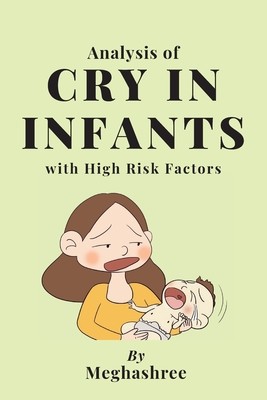
- We will send in 10–14 business days.
- Publisher: independent Author
- ISBN-10: 2990884319
- ISBN-13: 9782990884310
- Format: 15.2 x 22.9 x 1.8 cm, minkšti viršeliai
- Language: English
- SAVE -10% with code: EXTRA
Analysis of Cry in Infants With High Risk Factors (e-book) (used book) | bookbook.eu
Reviews
Description
Crying is the first sign of life at birth. Crying is the first way in which an infant communicates with the world. Crying is the infant's most powerful and most often the only means of communication. Crying is a sequence of behavior patterns that is part of the largest behavioral repertoire of the infant. It is an innate behavior that plays a fundamental role in the survival, health, and development of the child, for the neonate and young infant, crying is the primary mode of expressing and communicating basic needs and events. Several studies have shown that the anatomical, physiological and psychological conditions of infants determine characteristics of the cry sound i.e., the acoustic characteristics. Increasingly, a number of researchers are beginning to view crying and its perception as an interpersonal event. That is, crying has been viewed as a social event, as a system of communication. It may serve as a signal of distress. There has been a number of studies on this aspect of crying and the consequences of its perception and response by caregivers.
A cry is a signal which can be used to evaluate the neuro-respiratory and phonatory function of infants. Infant cries whose acoustic properties persistently severely deviate from the normal have been reported to be associated with chronic poor health. The abnormal infant cry has been found to be associated with chromosomal, endocrine, metabolic, and neurological disturbances. Studies have been carried out to identify the different cry patterns that have been associated with high-risk babies. The infant cry has been characterized as constellations of acoustically distinct cry types, indicating specific needs such as hunger, pain cries as well as malnourishment, toxicity, and low birth weight. In other words, it has been shown that infants with acoustically abnormal cries are liable for long-term risk.
EXTRA 10 % discount with code: EXTRA
The promotion ends in 22d.05:59:03
The discount code is valid when purchasing from 10 €. Discounts do not stack.
- Publisher: independent Author
- ISBN-10: 2990884319
- ISBN-13: 9782990884310
- Format: 15.2 x 22.9 x 1.8 cm, minkšti viršeliai
- Language: English English
Crying is the first sign of life at birth. Crying is the first way in which an infant communicates with the world. Crying is the infant's most powerful and most often the only means of communication. Crying is a sequence of behavior patterns that is part of the largest behavioral repertoire of the infant. It is an innate behavior that plays a fundamental role in the survival, health, and development of the child, for the neonate and young infant, crying is the primary mode of expressing and communicating basic needs and events. Several studies have shown that the anatomical, physiological and psychological conditions of infants determine characteristics of the cry sound i.e., the acoustic characteristics. Increasingly, a number of researchers are beginning to view crying and its perception as an interpersonal event. That is, crying has been viewed as a social event, as a system of communication. It may serve as a signal of distress. There has been a number of studies on this aspect of crying and the consequences of its perception and response by caregivers.
A cry is a signal which can be used to evaluate the neuro-respiratory and phonatory function of infants. Infant cries whose acoustic properties persistently severely deviate from the normal have been reported to be associated with chronic poor health. The abnormal infant cry has been found to be associated with chromosomal, endocrine, metabolic, and neurological disturbances. Studies have been carried out to identify the different cry patterns that have been associated with high-risk babies. The infant cry has been characterized as constellations of acoustically distinct cry types, indicating specific needs such as hunger, pain cries as well as malnourishment, toxicity, and low birth weight. In other words, it has been shown that infants with acoustically abnormal cries are liable for long-term risk.


Reviews